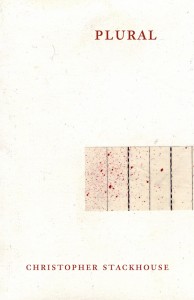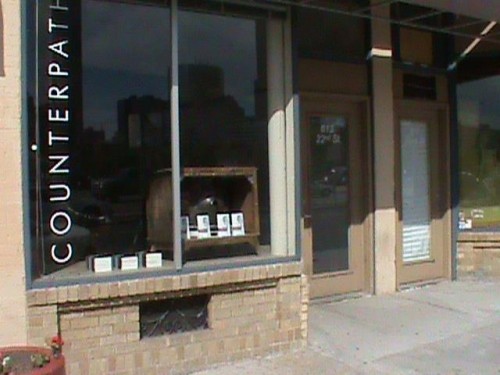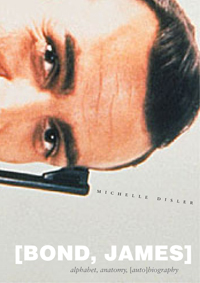Plural by Christopher Stackhouse
 Plural
Plural
by Christopher Stackhouse
Counterpath, Nov 2012
64 pages / $14 Buy from SPD or Amazon
It wouldn’t be wrong to call the poems in Plural slippery: content just eludes you, as does the floor plan of a consistent or memorable form. Stackhouse has a playful but terse and lateral style that leads you to wonder why most poems start or stop where they do or aren’t combined. Two careful reads didn’t reveal many clues for the reader so, like I mentioned, while the book is interesting in synopsis form the individual poems stay slippery, just out of reach.
And to present the book in synopsis form: Plural incorporates poems in the same tone but different formatting strategies, notes from art world lectures that are interestingly similar to the poems, and a movement across the course of the book from being concerned with the mind and consciousness to reveling in the body. The lecture notes are actually some of the most interesting parts of the book because not only do they give the surrounding poems context, they serve as a map for Stackhouse’s cognition. And although the notes are about primarily visual art, a lot of what Stackhouse notes bleeds into not just his writing but the idea of writing, as in “Notes from Panel Disc. @ The Fish Tank Gallery”:
The artist takes a position based on how s/he sees itself in
contextual dialogue (art historical?) with the human condition.
The artist interprets his/her world to create meaning, or/and,
comment on the way meaning may be transmitted.
Those last two lines are important as applied to Stackhouse’s mostly brief poems, which seem more concerned with transmitting meaning than creating it and lack much broader context other than being in the same book. This is not a bad thing; if you’re looking for lots of meaning consult your local public library for probably a few dozen books of free verse heavily into creating meaning, for what it’s worth. But the poems arrive with the same matter-of-fact record-keeping as the lecture notes, which can render them frustrating at times not because you’re desperately searching for meaning but because you’re wondering, given the consistency, “why X and not Y?”
An example of the bulk of the book follows, from a poem about midway through titled “Chew the Candy”:
from a crack in the concrete laid in an alley brutal
but potential for a lawn. Lounge there easy.
Find the line and then straddle it. Stroke the pole.
Probe the hole. Be comfortable in all that is not
there.
August 26th, 2013 / 11:00 am
An Interview with Tim Roberts, Co-Founder of Counterpath in Denver
I’ve been thinking a lot over the last year about how to nurture innovative writing communities and build structures to support those communities in places where they don’t exist, or where the existing structures are rickety or shoddy. About ways to create horizontal networks of writers interested in dialogue and exchange about art and writing outside of a university context. Maybe it’s because I’ve spent too many hours at readings with authors aiming for the NYC big leagues and elbowing each other for position. Too many evenings listening to the same “good story” or “good poem” lectures. Disappointed and often frustrated by the lack of innovative lit/art endeavors outside of a handful of big cities (and smaller centers), I’ve been looking for models for building innovative / small press / interdisciplinary writing communities in all the places we live.
As I set out to look for different examples, one kept coming up: Tim Roberts and Julie Carr’s work to build Counterpath in Denver, Colorado. Counterpath combines so many things: a press, a bookstore, a gallery, a performance space; their focus on the work of writers and artists who are driven to make “linguistic and visual interventions in contemporary global culture” seems spot-on. I am particularly drawn to Counterpath because their definition of what is “new” seems broad and because they are explicitly interested in work from groups often under-recognized in the experimental literary universe: people of color, women, queers. And their list of readings and events made me oh-so-excited: CA Conrad, Rodrigo Toscano, giovanni singleton, Lisa Robertson, Eleni Sikelianos. They’ve collaborated on events with Ugly Duckling Presse and Coffee House Press. I wondered how they did it all, how it all started and wanted to see if there was something I could learn from their experiences. Of course, being in the experimental hotbed of the Denver/Boulder area makes their job a bit easier, but I still wondered how they’d done it. There’s a great interview by Noah Eli Gordon with Julie Carr on the Volta that addresses some of these questions, but I still had more questions when I finished reading it.
So I sent Tim Roberts at Counterpath an email to see if he could give more details about the kind of work they’re doing. This interview is the result. Enjoy.
 JP: How did you and Julie Carr begin Counterpath? Why and when? Was it originally a press or a space or a bookstore? Which came first? How did the other pieces develop over time?
JP: How did you and Julie Carr begin Counterpath? Why and when? Was it originally a press or a space or a bookstore? Which came first? How did the other pieces develop over time?
TR: We were living in Oakland, CA, when we started the press, in January of 2006. Julie was finishing a Ph.D. in English at UC Berkeley and I was working in book production at Stanford University Press. Both of us were doing a lot of writing, and then at that point I thought I could deal with most of what was necessary in terms of making the books, including design. The press project itself kind of just came to us and seemed like a natural progression of what we were already doing. We thought it might be useful in two distinct ways, in that it was a project grounded in a broad concept of writing itself, picking up from writers like Blanchot—not necessarily connected to a book, or ink on paper—and that responded to a sense of I guess political hopelessness when the US actually re-elected George W. Bush in 2004.
[BOND, JAMES]: alphabet, anatomy, [auto]biography
 [BOND, JAMES]: alphabet, anatomy, [auto]biography
[BOND, JAMES]: alphabet, anatomy, [auto]biography
by Michelle Disler
Counterpath Press, 2011
120 pages / $14.95 Buy from Counterpath, Amazon or SPD
Superficially [Bond, James] is an exploration of the Bond character as he appears in Ian Fleming’s novels: rescuing girls, thwarting villains, escaping from dangerous situations, and smoking a ton of cigarettes. What’s fascinating and brilliant and great about the book, though, is that we get this exploration and some rumination on the masculinity it represents not in standard linear nonfiction prose but as a series of lists and games and experiments. This makes the book worth your entertainment dollar in a variety of ways: as an investigation of a popular icon/fictional character, as a look at what represented the summit of masculinity 1953-1965 and how the ideal is shored up through the use of women (and villains) as disposable props, and as a really stunning example of how brilliant innovative nonfiction can be when it’s not afraid to take a lot of risks.
And the book does take risks. Divided into the three sections of the subtitle, the text never offers a moment of scholarly distance but instead offers you a spread of cross-sections of Bond as character and as archetype. In the first section, alphabet, you get just that: an alphabet comprised mostly of lists of common people, objects and events in Bond’s world. For example D is for “Dislikes” and you get a two-page inventory of things like the following:
October 29th, 2012 / 12:00 pm
